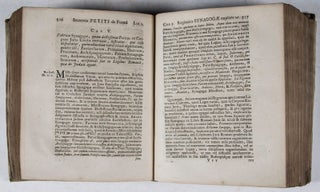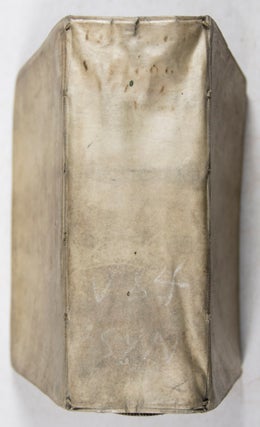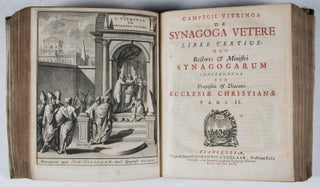De synagoga vetere libri tres: quibus tum de nominibus, structurâ, origine, præfectis, ministris, & sacris synagogarum, agitur; tum præcipue, formam regiminis & ministerii earum in ecclesiam christianam translatam esse, demonstratur: cum prolegomenis. 2 vols bound in one (Complete)
Franequerae (Franeker): Johannis Gyzelaar, 1696. Second edition. Hardcover. Octavo (8 1/4 x 6 1/2"). Vol. 1: [32], 256, 253-608 p.; Vol. 2: [8], [609]-1138, [38]pp. Contemporary full vellum with handwritten title to spine. Identical additional engraved title by Joseph Mulder (1658-1742), a Dutch Golden Age printmaker and engraver, for each of the two parts. Vol. 2 has title: Campegii Vitringa De synagoga vetere liber tertius : quo rectores & ministri synagogarum conferuntur cum præpositis & diaconis ecclesiæ Christianæ. Pars II. Both title pages in red and black lettering. Title vignettes. Decorative woodcut head-, tailpieces and initials.
Originally published in 1685, this work is the second edition of Vitringa's dissertation on the synagogue and the development of the early Church.
The term "synagogue" (like the word church) signifies first the congregation, then also the building where the congregation meet for public worship. As the Christian Church rests historically on the Jewish Church, so Christian worship and the congregational organization rest on that of the synagogue, and cannot be well understood without it.
Vitringa's work explains that the Christian Church was framed on the model, not of the temple, but of the synagogue, just as its Sacraments arose out of Jewish ordinances which had no connection with the temple services.
Includes two extensive indexes at rear (Vol. 2), as well as an Addenda and and emendanda in Vol. 2, p. [36]-[38] (last sequence).
Binding age-toned and partly darkened. Handwritten title partly faded on spine. Ex-library bookplate on inside of front cover, and stamp on first title page. Water-staining to both endpapers and fly leaves, as well as at verso of first additional engraved title and at inner margin of first title page. Front hinge starting. Very first and very last pages slightly rippled due to damp exposure. Sporadic clear water-staining along edges of very first and very last pages (not affecting lettering). Text in Latin with some Hebrew. Binding in overall good- to good, interior in good- to very good condition. g- to vg. Item #43173
About the author: Campegius Vitringa (1659-1722) was a Dutch Protestant theologian and Hebraist. A follower of Johannes Cocceius,Vitringa was a supporter of prophetic theology. He was educated at the universities of Franeker and Leiden, and became professor of Oriental languages at the former in 1681. When locating prophetic outcomes, he would associate events to the near rather than the far-off future, placing a distinct focus on the period of the Maccabees (2nd Century BC). Like Joseph Mede (1586-1638), Vitringa believed wholeheartedly that the Millennium was yet to come, but did not expect any immediate changes. He relegated the end of the time to a remote future and strongly emphasized the concept of New Jerusalem (From Wikipedia).
Price: $500.00




